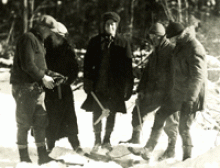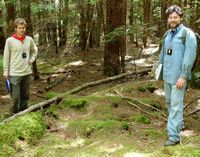You are here
Bob Marshall's Research Plots Recovered and Resampled

In the summer of 1924, Bob Marshall, future founder of the Wilderness Society and career forester and ecologist for the U.S. Forest Service and Department of Indian Affairs came to Petersham to join four other graduate students for studies with Professor Richard Fisher and instructors Albert Cline and Rupe Gast. The group developed a large new experiment on the Tom Swamp tract to examine forest regeneration and dynamics following different logging treatments. Marshall analyzed the land-use history of the tract, extensively sampled tree rings to determine long-term growth trends and established a 80 x 200 foot plot for intensive study. His work is documented in Harvard Forest Bulletin 11: The Growth of Hemlock Before and After Release from Suppression. Following Marshall's departure in 1925, the 1938 hurricane and subsequent harvesting, the plot was lost.
 This summer, as part of a long-term study of forest dynamics, land use history and conservation coordinated by David Foster, Summer Research Program students Alex Ireland (Clarion University) and Ben Mew (Oberlin College) are exploring the experimental tract in detail and reconstructing Marshall's study. Through a painstaking process they have relocated and permanently marked Bob Marshall's plot. Sampling of the current forest on the site confirms Marshall's prediction, based on his own historical work, that hemlock and white pine would predominate across the area, regardless of treatment.
This summer, as part of a long-term study of forest dynamics, land use history and conservation coordinated by David Foster, Summer Research Program students Alex Ireland (Clarion University) and Ben Mew (Oberlin College) are exploring the experimental tract in detail and reconstructing Marshall's study. Through a painstaking process they have relocated and permanently marked Bob Marshall's plot. Sampling of the current forest on the site confirms Marshall's prediction, based on his own historical work, that hemlock and white pine would predominate across the area, regardless of treatment.

